General election 2019: preview of North East England
The 2019 general election presents voters with a complex task of choosing which party can best represent their Leave versus Remain view, as well as their policy preferences or left/right ideology. On the ground local circumstances vary a lot. In the run-up to the 12 December polling day, the Democratic Audit team will preview the elections in each of the UK’s regions in turn. We start with the North East of England, focusing on the key seats identified from the results in 2017, the latest polling, and how insurgent parties and the Leave-Remain background affect the contest in each area.
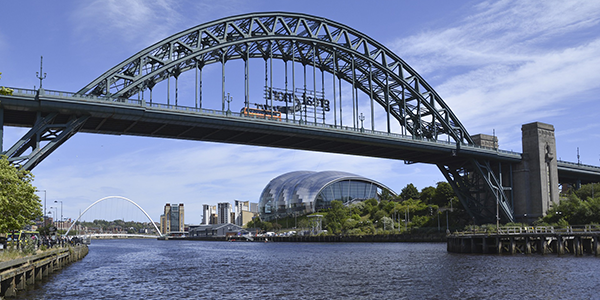
Picture: yorkshireman from Pixabay
The smallest region in England, the North East region includes Northumberland, Tyne and Wear, County Durham and Cleveland. It was previously very stable in terms of Labour party dominance, with very few seats changing hands over successive elections (see Figure 1). However, the region was a strong Leave area (58%) in the 2016 referendum, which threatened to create an opportunity for the Conservatives or UKIP to break the mould in 2017. In the event, the region’s results were much the same as in 2015 with 26 Labour and 3 Conservative MPs elected. Two seats did change hands. One (Middlesbrough South East and Cleveland) switched from Labour to Conservatives, while neighbouring Stockton South was a Labour gain from the Conservatives. Both seats are key ones to watch this time round (see below). The region has had the lowest turnout outside of Northern Ireland on 66%.
Map showing the 2017 general election results in the North East
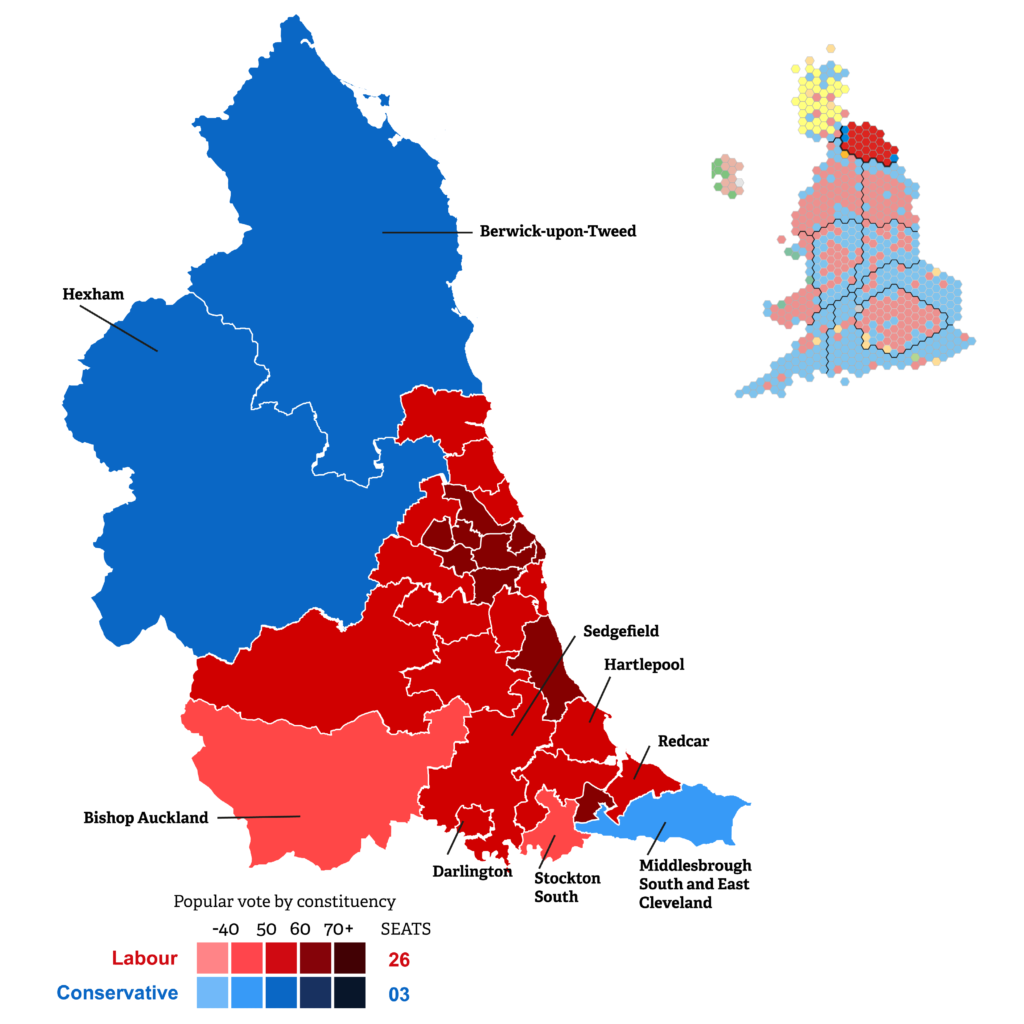
Source: Adapted from map by DrRandomFactor & Ch1902 /Wikipedia. Key constituency contests for 2019 labelled.
For all seats in the region, you can find full details of the candidates standing in 2019 and their social media links (so you can see what kind of a person they are and what issues they focus on) at DemocraticDashboard.com. It also gives complete results from the 2017 general election in each area, estimated 2016 EU referendum results and details about the constituency so you can best make up your own mind how to vote.
The estimated constituency results for all seats in the North East in 2019, and regional vote shares given in figures 1 and 2, come from YouGov’s large MRP poll published on 27 November and are the best available at time of writing. A sample of 100,319 people was polled across the UK, and used, along with demographic and other data, to create estimates for each constituency.
Figure 1: Number of seats won by each party at the last three general elections in the North East, and latest estimates from YouGov polling, 27 November
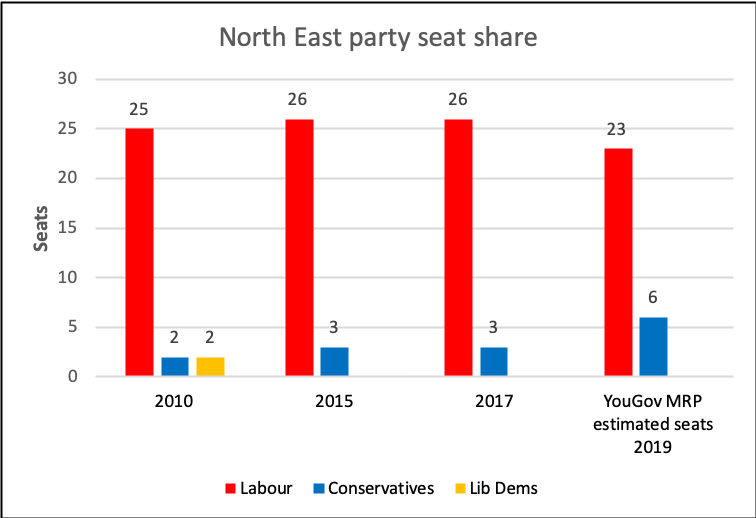
Note: 2019 figures from YouGov MRP seat estimates, 27 November, 2019.
Figure 2: Parties’ shares of the votes in the North East at the last three general elections, and estimated vote share in 2019 (YouGov, 27 November)
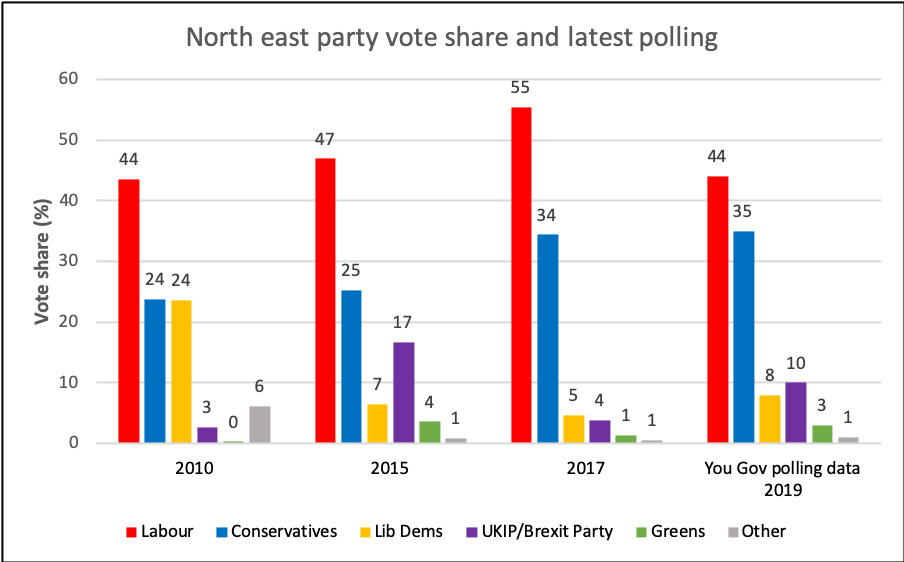
Note: 2019 data from Benjamin Lauderdale and Jack Blumenau for YouGov, 27 November.
We discuss first seats where Labour is on the defensive against Conservative or Brexit Party campaigns and targeting; next, the few seats that the Conservatives are defending from Labour or the Liberal Democrats; and last the Liberal Democrats’ targets.
Labour seats that are Conservative or Brexit Party targets
With most seats to defend, but national opinion poll numbers that are not so far buoyant, Labour has most to lose on 12 December. According to YouGov’s MRP poll three current Labour seats are likely to switch to the Conservatives: Bishop Auckland, Stockton South and (narrowly) Darlington.
Bishop Auckland is the most marginal seat in the region from last time (see Figure 3). It also has a high Leave vote share of 60% in the Brexit referendum. Unless Boris Johnson can win in seats like this the Conservatives have little hope of gaining a majority. There are four candidates standing, for Conservatives, Labour, Lib Dems and the Brexit Party, but essentially, as in 2017, this is a two-horse Labour–Conservative race.
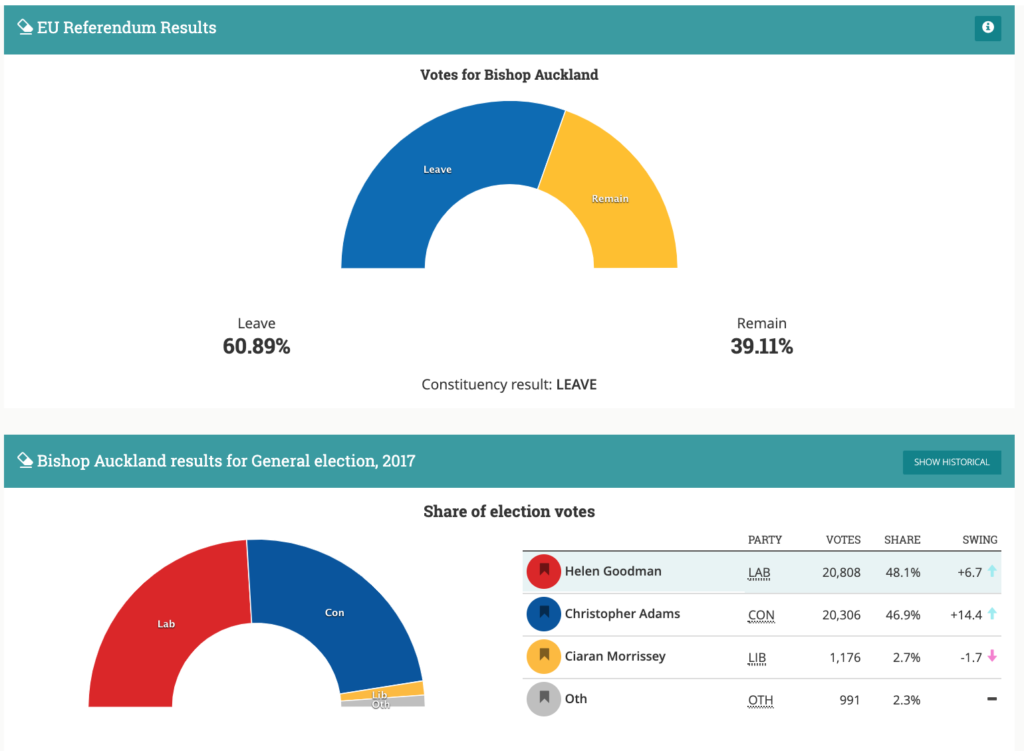
Source: Democratic Dashboard
The forecast is similar for Stockton South, an ultra-marginal one for Labour, and with a high Leave vote. In fact, Labour very narrowly took this seat from the Conservatives in 2017. Again, a Brexit Party candidate is standing, which could split the Leave vote. Darlington also fits the high Leave vote pattern, with a two-party race, but it has a somewhat larger Labour majority – so that YouGov’s prediction of a very narrow Tory victory here was something of a shock for Labour strategists. The Brexit Party presence might help the sitting MP (Jenny Chapman) to hang on. Two more Labour seats, Tony Blair’s former seat of Sedgefield and Stockton North are still predicted to be narrowly retained by Labour on the latest polling, but are perhaps too close to call.
For the Brexit Party, Hartlepool is a key target. The UKIP vote held up here in 2017, giving them their second-highest result across the country, and Farage’s former party also came second here in 2015. In 2016 the area was estimated to have the highest Leave vote in the region at 70%. As a result, this is the top target for BP nationally and their candidate is the party chairman, Richard Tice. The BP presence could limit the Conservatives’ ability to win this target seat from Labour, who have held it since the seat’s creation in 1974. The latest YouGov polling predicts Labour retaining 40% support, the Conservatives coming second with 31% and the Brexit Party on 23% support.
On a very bad night for Labour, some other seats might just be at risk – in North West Durham (Shadow cabinet member Laura Pidcock has a majority of 8,792); and in Blyth Valley (where sitting MP Ronnie Campbell is standing down). There might even be a chance of an upset in Sunderland Central (22% Lab majority, 60% Leave voting), which usually declares its results early, around midnight. The seat should be safely Labour – but the size of any swing against Labour here will be an early indicator of how the party is performing on the ground on election night.
Seats the Conservative are defending
Middlesbrough South and East Cleveland is one of the six seats that the Conservatives took from Labour in 2017 as part of their strategy of targeting the ‘Labour Leave’ strongholds, when there were only 1020 votes between the two parties. Because there is a sitting Tory MP the Brexit Party is not running a candidate here, which will help the incumbent. Current polling estimates predict that it will remain safely Conservative, despite its pre-2017 history as a Labour seat.
Hexham looks to be a safe Tory since it has returned a Conservative consistently 1951. However, this is one of the few seats in the North East where most people voted to Remain (estimated at 55% in the referendum). With the risk of any Corbyn government receding, Remain tactical voting sites are seeking to encourage Tory Remainers and Liberal Democrats to forget their misgivings and back to the Labour candidate here, since they came second in 2017. A complication is that campaign group Best for Britain’s MRP polling at the start of the campaign did recommend the Lib Dems. No Brexit Party candidate is standing.
Seats where the Liberal Democrats are most hopeful of performing well
Holding no seats currently in this region, the Liberal Democrats have focused most on Berwick-upon-Tweed which the party once held (until 2015). This is also the only seat in the region where the party is running more than a distant third. In 2017, voters split three ways, giving the Conservatives over 52%: Labour were in second place with just under 25%, and the Lib Dem vote share held up at 21%. YouGov’s MRP estimates now put the Conservatives on the same support (boosted by there being no Brexit Party candidate), with the Lib Dems running second on 24% to Labour’s 20%, in line with a recent constituency poll, which puts the Conservatives strongly in the lead. At present most, but not all, of the Remain tactical voting sites suggest that their supporters should back the Lib Dems.
Figure 3: The North East’s most marginal seats (by % vote) from the 2017 election
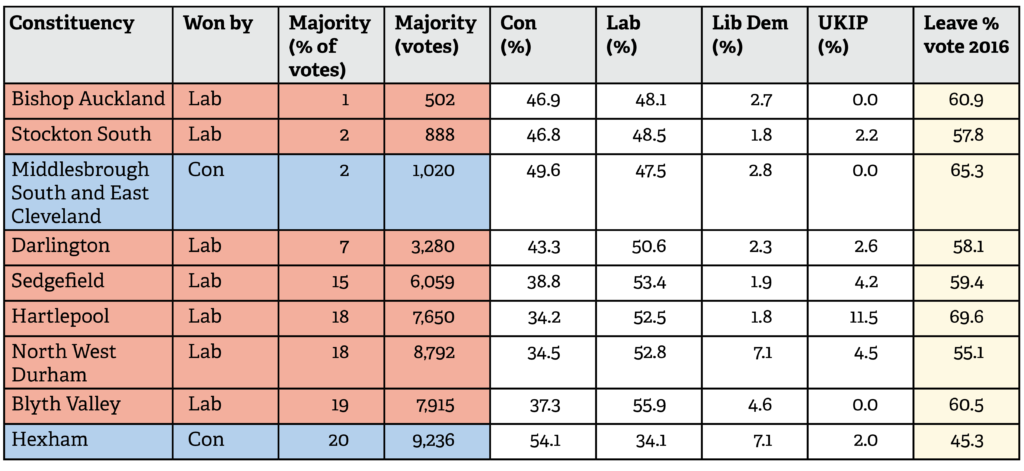
Note: The Leave % for each the 2016 Brexit referendum by constituency (and mentioned throughout this article), are Chris Hanretty’s estimates. You can also find these for each constituency (including those we don’t discuss), along with general election results at DemocraticDashboard.com.





 Democratic Audit's core funding is provided by the Joseph Rowntree Charitable Trust. Additional funding is provided by the London School of Economics.
Democratic Audit's core funding is provided by the Joseph Rowntree Charitable Trust. Additional funding is provided by the London School of Economics.